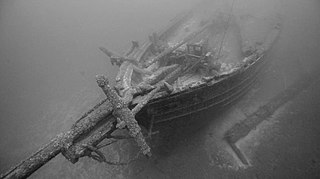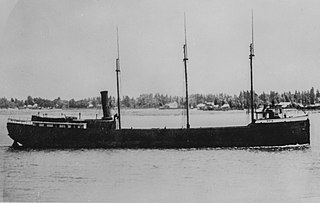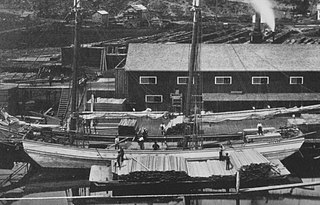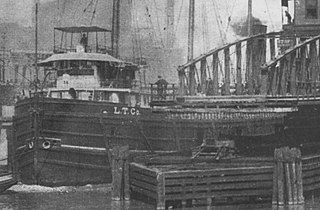
The SS Regina was a cargo ship built for the Merchant Mutual Line and home ported in Montreal, Quebec. Named after Regina, Saskatchewan, Regina had a tonnage of 1,956 gross register tons (GRT) and a crew of 32.
Gallinipper was a schooner that sank in Lake Michigan off the coast of Centerville, Manitowoc County, Wisconsin, United States. In 2010, the shipwreck site was added to the National Register of Historic Places.
Home was a two-masted schooner which sank in Lake Michigan off Centerville in Manitowoc County, Wisconsin, United States, in 1858. In 2010 the shipwreck site was added to the National Register of Historic Places.

The F.T. Barney was a 19th-century American schooner that sank in 1868. Her wreck in Lake Huron near Rogers City, Michigan, was listed on the National Register of Historic Places in 1991.

The SS Pewabic was a package freighter that served ports on the Upper Great Lakes. She was launched in October 1863, fitted out in the spring of 1864, and was in active service until she sank off Thunder Bay Island in Lake Huron on August 9, 1865, due to collision with her sister vessel. There was significant loss of life, with a number variously estimated at 100 or 125 passengers and crew of the stricken vessel going down with the ship. If the higher number is accepted, the loss of life made this disaster, in terms of loss of life from the sinking of a single vessel, the seventh-worst tragedy in the history of the Great Lakes, and the worst ever on Lake Huron. The sunken hull of the package freighter is a feature of the present-day Thunder Bay National Marine Sanctuary.

The Norman was a bulk freighter; its wreck in Lake Huron was listed on the National Register of Historic Places in 2016.

Grecian was a steel bulk freighter built in 1891 by Globe Iron Works at Cleveland, Ohio. She was a sister ship to Norman, also wrecked nearby. The ship was 296 feet (90 m) long, with a beam of 40 feet (12 m) and a gross register tonnage of 2,348 tons.

SS D.R. Hanna was a 552-foot (168 m) long American Great Lakes freighter that operated on the Great Lakes from November 12, 1906 to her sinking on May 16, 1919 after a collision with Quincy A. Shaw. D.R. Hanna was like many other freighters, and was used to haul bulk cargoes such as iron ore, coal and grain.

SS Choctaw was a steel-hulled American freighter in service between 1892 and 1915, on the Great Lakes of North America. She was a so-called monitor vessel, containing elements of traditional lake freighters and the whaleback ships designed by Alexander McDougall. Choctaw was built in 1892 by the Cleveland Shipbuilding Company in Cleveland, Ohio, and was originally owned by the Lake Superior Iron Company. She was sold to the Cleveland-Cliffs Iron Company in 1894 and spent the rest of her working life with it. On her regular route between Detroit, Escanaba, Marquette, and Cleveland, she carried iron ore downbound, and coal upbound.

SS Robert Wallace was a wooden-hulled American bulk freighter that served on the Great Lakes of North America from her construction in 1882 to her sinking in 1902 on Lake Superior near the town of Palmers, St. Louis County, Minnesota, United States. On November 17, 1902 shortly after leaving Superior, Wisconsin with a cargo of iron ore, Robert Wallace sprang a leak and sank. Her wreck was found in 2006, and on October 14, 2009, the wreck of Robert Wallace was listed in the National Register of Historic Places.

Antelope was a Great Lakes steamship that later was converted into a schooner barge) and sank in Lake Superior near the Apostle Islands in 1897.

The SS Lakeland was an early steel-hulled Great Lakes freighter that sank on December 3, 1924, into 205 feet (62 m) of water on Lake Michigan near Sturgeon Bay, Door County, Wisconsin, United States, after she sprang a leak. On July 7, 2015, the wreck of the Lakeland was added to the National Register of Historic Places.

SS Ohio was a wooden hulled Great Lakes freighter that served on the Great Lakes of North America from her construction in 1875, to her sinking in September 1894 when she collided with the schooner barge Ironton which also sank in the collision. Ironton was being towed by the steamer Charles J. Kershaw, which was also towing the schooner Moonlight. Ohio was found upright in 2017, over 122 years after her sinking in over 200 feet of water off Presque Isle, Michigan. In March, 2023, it was announced that Ironton had been located in 2019. The researchers who discovered Ohio plan to nominate her for a listing in the National Register of Historic Places.

The Mayflower was a wooden hulled scow-schooner that sank on June 2, 1891, in Lake Superior near Duluth, Minnesota, United States, after capsizing with a load of sandstone blocks. In 2012 the shipwreck site was added to the National Register of Historic Places.

SS Florida was a wooden hulled Great Lakes freighter that served on the Great Lakes of North America from her construction in 1889, to her sinking in May 1897 when she collided with the larger wooden hulled freighter George W. Roby. Her wreck was located by Ed Ellison in July 1994, in 206 feet (63 m) of water almost completely intact, save for her stern.

SS Etruria was a steel hulled lake freighter that served on the Great Lakes of North America from her construction in 1902 to her sinking in 1905. On June 18, 1905, while sailing upbound on Lake Huron with a cargo of coal, she was rammed and sunk by the freighter Amasa Stone 10 miles (16 km) off Presque Isle Light. For nearly 106 years the location of Etruria's wreck remained unknown, until the spring of 2011 when her wreck was found upside down in 310 feet (94 m) of water.

SS Russia was an iron-hulled American Great Lakes package freighter that sank in a Lake Huron gale on April 30, 1909, near DeTour Village, Michigan, with all 22 of her crew and one passenger surviving.

SS Chester A. Congdon was a steel-hulled American lake freighter in service between 1907 and 1918. She was built in 1907 by the Chicago Shipbuilding Company of South Chicago, Illinois, for the Holmes Steamship Company, and was intended to be used in the grain trade on the Great Lakes. She entered service on September 19, 1907, when she made her maiden voyage. In 1911, Salt Lake City was sold to the Acme Transit Company. A year later, she was transferred to the Continental Steamship Company, and was renamed Chester A. Congdon, after lawyer and entrepreneur Chester Adgate Congdon. She was involved in several accidents throughout her career.





















